Budget, Backpackers, Surfers, Beach Lovers, Naturalist, Hippie, Sun and Sand worshipers, Off the Beaten Path Paradise! Everyone is welcome at Zipolite!
Translate
A little about Playa Zipolite, The Beach of the Dead . . .
Playa Zipolite, Oaxaca, Southern Mexico, on the Pacific Ocean. A little bit about my favorite little get-away on this small world of ours.Zipolite, a sweaty 30-minute walk west from Puerto Angel, brings you to Playa Zipolite and another world. The feeling here is 1970's - Led Zep, Marley, and scruffy gringos.A long, long time ago, Zipolite beach was usually visited by the Zapotecans...who made it a magical place. They came to visit Zipolite to meditate, or just to rest.Recently, this beach has begun to receive day-trippers from Puerto Angel and Puerto Escondido, giving it a more TOURISTY feel than before.Most people come here for the novelty of the nude beach, yoga, turtles, seafood, surf, meditation, vegetarians, discos, party, to get burnt by the sun, or to see how long they can stretch their skinny budget.I post WWW Oaxaca, Mexico, Zipolite and areas nearby information. Also general budget, backpacker, surfer, off the beaten path, Mexico and beyond, information.REMEMBER: Everyone is welcome at Zipolite.ivan
Zipolite Blog Links
- Playa Zipolite
- Zipolite Entertainment, Party, Sports, Dance, Clubs, Music - - - Zipolite Entretenimiento, Fiesta, Deportes, Baile, Discotecas, Música
- Zipolite Food, Drink, Sunrise, Sunset - - - Zipolite Comida, Bebida, Amanecer, Atardecer
- Zipolite Nudist - - - Zipolite Nudista
- Zipolite ... Rentals, Camping, Hammocks, Apartments, House - - - Zipolite ... Alquileres, Camping, Hamacas, Apartamentos, Casa
- Zipolite Tours - - - Tours en Zipolite
- Zipolite Transportation and Rentals, Taxis, Bike, Moped, ATV - - - Zipolite Transporte y Renta, Taxis, Bicicleta, Ciclomotor, Cuatrimotos,
- Zipolite Yoga, Relax, Meditation, Temazcal - - - Zipolite Yoga, Relax, Meditación, Temazcal
- Budget Backpackers Off The Beaten Path - - - Mochileros económicos fuera del camino trillado
- Just For Fun ... by iVAn - - - Solo por diversión... de iVAn
- Near Zipolite - - - Cerca de Zipolite
- Travel Mexico - - - Viajes México
- ALL Playa Zipolite Blogspot Dot Com - - - TODO Playa Zipolite Blogspot Dot Com
Sunday, June 25, 2017
Oaxaca beaches / Playas Oaxaqueñas JEDR© JEDR©
Oaxaca beaches / Playas Oaxaqueñas
Published on Jun 18, 2017
Playa Aragon a kilómetro y medio de Zipolite rumbo a Mazunte.
Beach Aragon to mile and a half of Zipolite heading for Mazunte.
Beach Aragon to mile and a half of Zipolite heading for Mazunte.
Heat wave continues; 52 C in forecast Chihuahua seeks emergency declaration to release federal funds
Heat wave continues; 52 C in forecast
Chihuahua seeks emergency declaration to release federal funds
Mexico News Daily | Friday, June 23, 2017
Weekend forecasts for the state of Chihuahua are for temperatures even higher than those that brought a weather alert last week, when authorities warned of temperatures approaching 50 C.
Temperatures are forecast to reach 52 C this weekend in a heat wave that has helped fuel three large forest fires.
Last week’s weather warning applied to 11 municipalities but has now been extended to include a total of 30, where temperatures have consistently risen above 40 C.
The municipality of Moris in the Sierra Tarahumara has already reported temperatures above 50, a situation not reported there for years, said the state Civil Protection chief.
As a result, Virgilio Cepeda Cisneros has requested the federal government declare a natural disaster emergency.
With from the national disaster relief fund Fonden made available by such a declaration, Cepeda’s office will be able to provide bottled water, food and personal hygiene products, among other supplies.
In the municipality of Ciudad Juárez, authorities have been distributing drinking water in tanker trucks to the neighborhoods that require it, although the state Commission for Protection Against Health Risks warned it was not fit for human consumption.
Mayor Armando Cabada Alvídrez rejected the warning by drinking water from one of the trucks himself to prove it was drinkable.
In three other municipalities, three forest fires have been blazing for nearly 15 days.
The National Forest Commission (Conafor) said yesterday the fires in the municipalities of Madera, Gómez Farías and Guerrero were the largest in the state. At least 10 were burning yesterday.
“Up to June 16, there have been 618 fires that have affected an area of 43,876 hectares,” said Conafor in a statement.
The agency dispatched an additional 10 brigades to reinforce efforts to fight the fires, which state authorities confirmed continue to burn but “the brigades have under control.”
The number of new fires dropped significantly during the last week after sporadic rain delivered some moisture to wooded areas, enough to impede the propagation of wildfires.
“Still, high temperatures and human neglect make small fires turn dangerous,” said a government spokesman.
Source: Milenio (sp)
http://mexiconewsdaily.com/news/soil-is-a-challenge-in-building-new-airport/?utm_source=Mexico+News+Daily&utm_campaign=7ba4c8abd0-June+24+active+users&utm_medium=email&utm_term=0_f1536a3787-7ba4c8abd0-348153685
Soil is a challenge in building new airport
'It's very muddy,' says an engineeer as work proceeds to slow the site's sinking
Mexico News Daily | Friday, June 23, 2017
Since Aztec times construction projects in the Valley of Mexico have faced unique challenges because of the lake-covered topography and spongy underlying soil.
Those same challenges remain today.
But at Mexico City’s new international airport, which is now beginning to take shape, work designed to slow down the sinking of the site is almost half finished.
The biggest progress to date has been the laying of a foundation designed to bring greater stability to the soft earth that was once covered by the waters of Lake Texcoco.
The system is called deep foundation or piling, with vertical piles inserted at depths of four to 11 meters to increase the ground’s capacity to bear the enormous weight to which it will be subjected.
A total of 5,564 concrete piles measuring between 15 and 21 meters long will be used and 2,612 of them are already in place, representing 47% completion of the construction stage.
According to Miguel Solís — a supervisor for Gami Ingenieria e Instalaciones, the company that manufactures, transports and installs the piles — land in the area is sinking at a rate of 1.5 to two centimeters a month, up to 24 centimeters a year, but the deep foundation system will reduce that by 50% and ensure that the inevitable sinking happens in a uniform fashion.
“The airport is going to continue sinking [but] the piles help to increase the bearing capacity so that the building doesn’t sink as quickly. The concrete slab will work independently, like a boat, without being bound to the piles. It’s called a flotation system. The terminal building is going to float on the old Texcoco Lake.”
The company is also working on a similar foundation system at the ground transportation center.
The perimeter of the x-shaped terminal building – conceived as an allusion to Mexico — has also been marked out and a 1.5-meter-thick slab of hydraulic cement reinforced with steel is expected to be poured next week over an area measuring 1.5 kilometers by 550 meters.
It was announced in January that a consortium led by Carlos Slim’s construction company had been awarded an almost $4 billion contract to construct the terminal.
Work has also begun on the construction of an air traffic control tower to the north of the terminal building and again the major challenge is preparing the land to bear significant weight.
The ground will be excavated to a depth of six meters where a 65-meter-diameter foundation slab will be placed to support the 90-meter tower.
Abel Casados, an engineer working on the tower construction, explained to the newspaper Milenio that due to the special characteristics of the soil at the site, the excavation will take place in two stages and geotechnical instruments will be used to monitor the behavior of the ground on a daily basis.
Casados added that the water content of the soil “is three or four times more salty than seawater,” which can affect the durability of the piles. So pozzolan and other additives are used in the structures to increase their resistance.
“It’s one of the main challenges of the ground. This soil is one of a kind in the world.”
Still, he remains confident that the project will be a success.
“It has been questioned a lot but Mexican engineering has all the experience [required] to carry out [the work to meet] all of these challenges.”
The muddy ground is one. “For every soil particle we have three water particles. It’s soil with 300% dampness; it’s very muddy.”
The US $13-billion airport is expected to begin operations in 2020 with three runways and a passenger capacity of 50 million per year before eventually reaching a capacity of 120 million passengers annually with six runways.
The existing airport is struggling to cope under increasing strain from passenger numbers, making the new project vital for the ongoing prosperity of one of the world’s largest cities.
Source: Milenio (sp)
8 Tips for Visiting the Mayan Ruins of Chichen Itza JUN 6 Posted by Ted Campbell
8 Tips for Visiting the Mayan Ruins of Chichen Itza
Posted by Ted Campbell
Chichén Itzá shot to international fame in 2007 when it was chosen as one of the New Seven Wonders of the World, along with places like Machu Picchu, the Roman Colosseum, and the Great Wall of China.
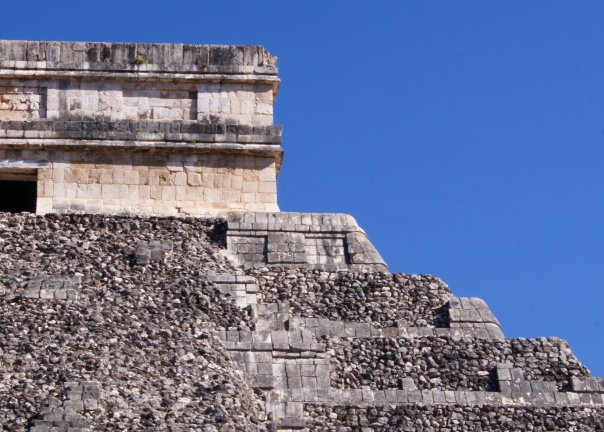
About three hours from Cancun, this enormous ancient Mayan city with limestone pyramids, skull carvings, and two cenotes (freshwater sinkholes) will give you a taste of the history of the region that you’d never get if you only stayed on the beach, sipping margaritas and eating bland resort tacos.
But for many travelers in Mexico, Chichén Itzá is like a good rock band that cool people don’t like anymore. It got too popular—a wonder of the world, after all—and there are so many other great ruins to see nearby: Tulum, Cobá, Palenque, Toniná, Tikal in Guatemala, and hundreds more. Some travelers I’ve met, people who were really into ruins, said they wouldn’t even go to Chichén Itzá.
There are big crowds, an inflated price, and aggressive hawkers behind tables stacked with t-shirts, pyramid statuettes, and other kipple. And since a Canadian spent the night on top of the Kukulkan pyramid and then met security in the morning with a big smile, only to be promptly hauled off to jail, none of Chichén Itzá can be climbed or entered, unlike other Mayan ruins.
But, come on! It’s Chichén Itzá. I couldn’t care less about lists, but it appears on one for a reason. It has some of the largest structures and most detailed architecture in the excavated Mayan world. The site is extensive—there’s much more to it than the famous Kukulkan pyramid (aka El Castillo), the top photo opportunity and the place where, on the spring and fall solstices, the setting sun casts strange shadows on the pyramid that resemble a slithering snake. (Expect huge crowds then.)
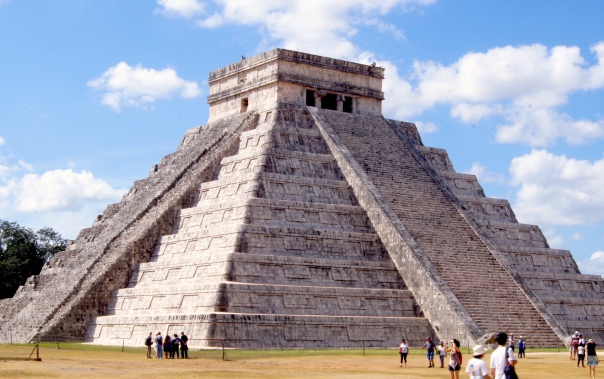
So, although Chichén Itzá may not be the best Mayan site for a steamy, mystical, Indiana Jones experience (try Palenque for that), it’s not nearly at a tequila museum level of tourist trap gaudiness for you to justify skipping it. Here are some tips that will help you make the most of your experience.
1. Don’t take a tour
Most resorts and all travel agencies offer guided tours to Chichén Itzá. Avoid them no matter what.
A proper visit takes three or four hours, at least. Look at the tour schedule—how long do you actually stay at the ruins? Probably much less. And can you walk around and discover the less-visited, out-of-the-way areas in the jungle? It’s doubtful. You’ll spend your time following a guy holding a big umbrella with all the other sheep, going where he wants to go, listening to his recycled jokes and blatant requests for tips.
Yes, it’s good to have an explanation of what you’re looking at, but (as I’ll explain below), it’s easy to hire a guide once you enter the ruins, or you could buy a guidebook at the gift shop.
Next, what time does your tour arrive at the ruins? Because if it’s an hour or more after the 8 AM opening time, the crowds will have already formed by the time you get there, especially if you go in high season (around Christmas, the week before Easter, or late July).
Sure, it’s convenient that most tours pick you up at your hotel, but this doesn’t actually save time. To the contrary—unless you’re the last one to board, you’ll be waiting while the bus picks everyone else up.
And how much does that tour cost? Compare with these prices for doing it on your own:
- Entrance fee: 232 pesos (154 for Mexican nationals)
- Round trip, first class ADO bus tickets from Cancun direct to Chichén Itzá: 320-500 pesos (depending on the schedule and if you buy tickets online)
- Round trip ADO bus tickets from Cancun to Valladolid: 220-450 pesos (depending on the schedule and if you buy tickets online)
- Passenger van from Valladolid to Chichén Itzá: 80 pesos
- Lunch at the overpriced (but good) restaurant at the entrance to the ruins: 150-300 pesos
- Lunch in Valladolid at an excellent restaurant: 100-300 pesos
Check exchange rates for pesos to your currency of choice here: http://coinmill.com
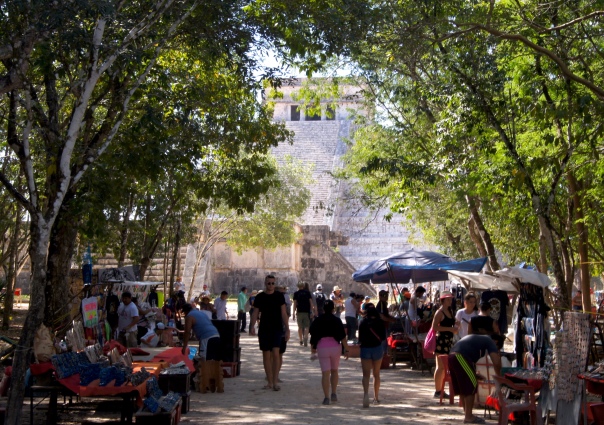
2. Take public transport instead
It’s totally possible to take a public bus from Cancun to Chichén Itzá and still make the 8 AM opening time. You’ll have to transfer in Valladolid (more on this pretty small town below), or wait until later to take the direct bus to the ruins.
The first ADO bus leaves downtown Cancun at 5:30 AM and arrives in Valladolid at 6:30 AM. It’s a two-hour trip, but with the time change between the states of Quintana Roo and Yucatan you’ll save an hour. The first bus from Playa del Carmen to Valladolid is similarly early, and with later departures all day.
Then in Valladolid, take a colectivo (passenger van for local travel) to get to the ruins. The colectivo lot is a block from the ADO bus station. They don’t have schedules; you just get on and wait, and once it’s full, it leaves.
Buses from Valladolid back to Cancun or Playa del Carmen leave regularly all afternoon, so perhaps the best plan (other than staying the night in Valladolid) would be to take the ADO bus direct to the ruins, then after your visit take a colectivo to Valladolid, have a late lunch, and then take the bus back to wherever you are staying (Cancun, Playa del Carmen, Tulum, etc.).
If you don’t want to deal with transfers, the only direct bus to Chichén Itzá leaves Cancun at 8:45 (thereby arriving around 10:45) and returns to Cancun at 4:30 p.m. (This is bound to change—for this an all other schedules, confirm on the website or at a bus station.)
The bus from Playa del Carmen direct to the ruins leaves at 8 AM and also arrives around 10:45.

Whatever you choose, visit the bus station to confirm schedules and buy your tickets the day before to avoid waiting in line in the morning.
You can also check the schedule on the ADO website, and if you buy tickets online you’ll get a discount. Then you can print them before your trip and just show up. The website is in Spanish but fairly straightforward.
ADO is the first-class public bus company, with buses as nice or better than a private tour bus. The ADO bus terminal is in downtown Cancun, not in the hotel zone by the beach. In Playa del Carmen the bus terminal is just a block from the beach, near the Cozumel dock.
3. Or rent a car
Even if you speak zero Spanish, there’s nothing to worry about when using ADO buses to get to Valladolid or Chichén Itzá. They are modern, clean and comfortable. Besides the cheaper price, the main difference between them and a guided tour is that you can choose your own schedule and visit both places at your own pace.
But if you don’t want to take an early-morning public bus, or if you have a large group of people (say, four or more), think about renting a car. You can rent cars everywhere in the Mayan Riviera, including the airport, which has Budget, Hertz, Enterprise, and all the rest. If you add up the bus tickets of all the people in your group, you may find that the car rental is cheaper.
The highways are good and relatively easy to follow, although be sure to look at a map before you go. After your visit, you can drive into Valladolid to have lunch and look around. It’s a direct drive from the ruins. Near Valladolid there are other ruins and some cenotes that are much easier to visit when you have a car.
Bring cash for the tolls coming from Cancun and Playa del Carmen, at least 300 pesos each way, and don’t forget about the time change between places on the Mayan Riviera and places in the state of Yucatan. When it’s 9:00 AM on the coast, for example, it’s 8:00 inland.
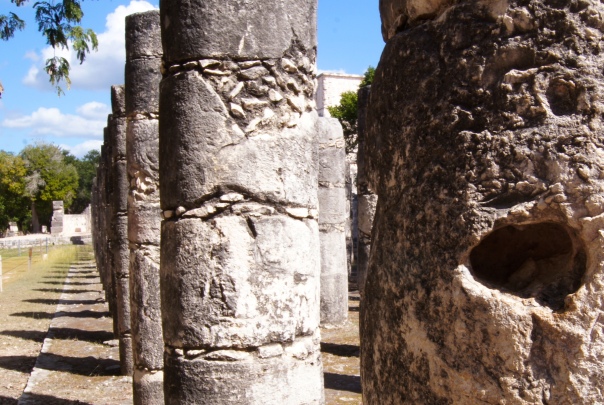
4. Stay in Valladolid the night before
If you have an extra day or two, the ideal way to visit Chichén Itzá is to stay in Valladolid the night before. You’ll have no problem making the 8 AM opening time at the ruins and you can come back whenever you’re ready. Plus, Valladolid is your best chance to get that authentic tourist experience you’ll never find in Cancun, no matter what the cheesy advertisements for restaurants or tourist attractions tell you.
Valladolid was founded in 1543 by Francisco de Montejo, the nephew of the conquerer of the Yucatán, Francisco de Montejo. Originally located elsewhere on the peninsula, it was moved to its present site in 1545, built over ruins of a Mayan city called Zací.
Like nearly every Mexican city, the exact center of Valladolid is the zócalo (central square or park), which is surrounded by hotels, restaurants, banks, government buildings, the cathedral, and the Bazar Municipal food court. And in all directions from the zócalo, Valladolid’s narrow streets have more parks, markets, museums, a cenote, a 16th-century convent—even a Buddhist temple. It’s a wonderful place to spend a few days and wander around.
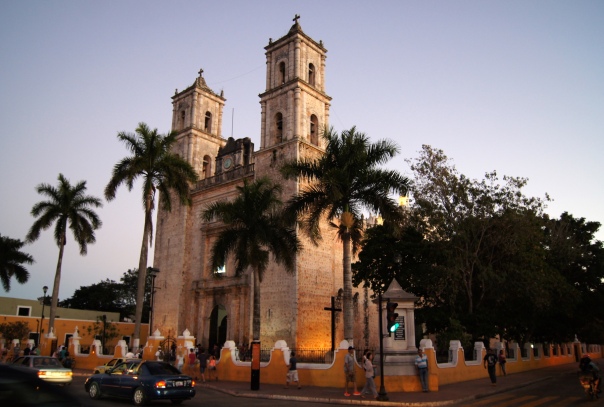
5. Hire a guide inside the park
Maybe there is a downside to not taking a guided tour—you’ll be wandering around the ruins with no idea what you’re looking at. Don’t despair, guides are everywhere.
If you drive to Chichén Itzá, when you start getting close you’re bound to be stopped at some roadblock, where official looking guys with laminated badges will try to get you to hire them as guides. You don’t have to stop at all (unless it’s the police), but if you do, expect these guys to quote higher prices than ones you’ll see later.
The same goes for when you walk toward the entrance—guides galore. If you meet one who gives you a good vibe, by all means hire him, but you’ll find the best prices once you’ve already paid and entered the park. Also, these are the “official” guides, so they may have a better idea of what they are talking about.
Besides price, also establish how long he will stay with you. I can’t give estimates on prices, which seem to change depending on high or low season and your level of Spanish. But I’d guess that anything less than 400 pesos for a few hours is a good deal. In low season, you might get lucky with 200 or less.
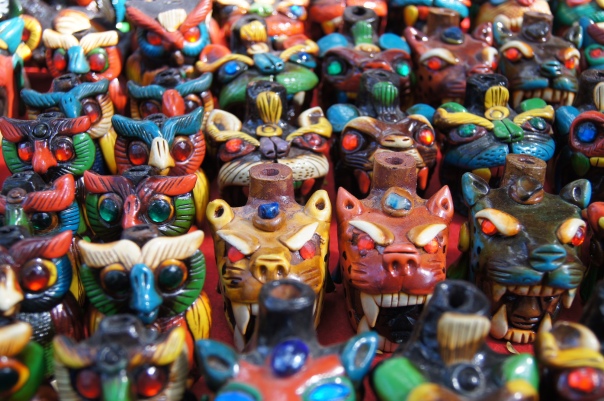
6. Or buy a guidebook from the bookstore
For those who are cheap or tour guide averse (both apply to me), just buy a guidebook at the bookstore/souvenir shop at the entrance. Get one with maps (useful for finding the out-of-the-way sections) and concise explanations of each area.
Remember, all knowledge about Chichén Itzá and other Mayan sites is really just speculation by archeologists. No one knows exactly what went on there, just as no one is really sure why the civilization collapsed long before the Spanish conquistadors arrived.
7. Don’t go on Sunday
Mexican nationals get in free on Sunday, so unless you’re Mexican, avoid Sunday to avoid the crowds.
I mentioned the high travel seasons earlier—a week or two before Christmas and after New Year’s, the week before Easter (called Semana Santa, a big holiday in Mexico), and late July (another time when many Mexicans have time off). If at all possible, avoid traveling to the area during these times, as many hotels increase their prices and places like Chichén Itzá can be quite crowded.
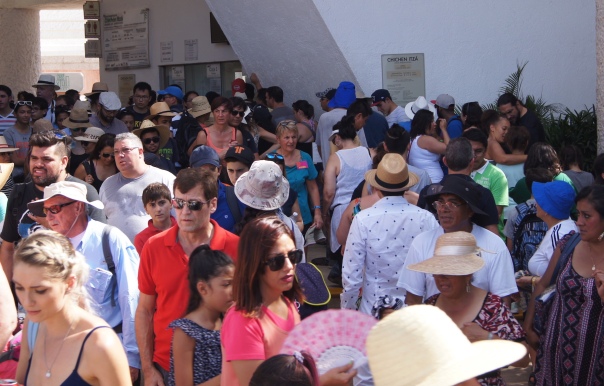
But don’t skip Chichén Itzá because of these crowds. Just get there early. At busy times, tour or no tour, do NOT arrive in the afternoon.
I went once during high season with my family, a few days after Christmas. We rented cars and arrived early, and when we left around 2 PM, the line of tour buses waiting to enter the totally full parking area went on for miles. Because the site closed at 5 PM, these people would spend more time on the bus than they would at the ruins, if they made it in at all. Doesn’t sound like fun to me.
8. Buy my guidebook
All these tips and many more are detailed in my guidebook to the region, the Cancun and Mayan Riviera 5-Day Itinerary. It’s for the independent traveler who likes the beach but also wants some culture. Besides saving a lot of money, you:
- Have two full days on two gorgeous beaches: Cancun and Playa del Carmen.
- Explore two Mayan ruins: Chichén Itzá, one of the new Seven Wonders of the World, and Tulum, a sunny fortress built on cliffs overlooking one of the most iconic beaches in Mexico.
- Dip your toe into local culture in Valladolid, a small colonial town in central Yucatán.
- Swim, snorkel, or scuba dive in the clear, freshwater Dos Ojos cenote.
- Eat what Mexicans eat: seafood, tacos, and Yucatán specialties like panuchos and salbutes.
- Shop, party, get tan, and learn some Spanish, history, and culture. And, if time permits, explore more places in the region, including Puerto Morelos, Isla Mujeres, Cozumel, the Cobá ruins, Xpu-Ha beach, and many more.
This part of Mexico may be the most visited, but in some ways the least understood. I try to remedy this with my guide.
From Amazon:
Subscribe to:
Posts (Atom)